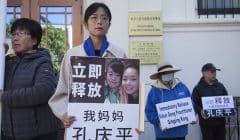Central Government Compound “Besieged”
Background: On April 23 & 24, 1999, police officers in Tianjin, a city near Beijing, assaulted and detained dozens of Falun Gong practitioners who had gathered outside a magazine office to discuss errors in a recently-published article attacking Falun Gong. Beginning in 1996, such articles started sporadically appearing in Chinese state-run media. Practitioners often responded with explanations to editors or occasional gatherings in front of the relevant media outlets, repeatedly prompting retroactive corrections and apologies. As word spread of the arrests in Tianjin and more Falun Gong practitioners inquired with officials, they were told they had to take their appeals to Beijing . The following day, April 25, some 10,000 Falun Gong practitioners spontaneously gathered at the central appeals office in Beijing, as they had been instructed to do by Tianjin officials. The gathering was peaceful and orderly. The practitioners’ demands were three-fold: to have a free and relaxed environment to practice Falun Gong, that a prohibition on the printing of Falun Gong books be reversed, and that the practitioners in Tianjin be released. Several Falun Gong representatives were called in to meet with Chinese Premier, Zhu Rongji, and members of his staff. That evening, the concerns of Falun Gong practitioners were met, the detained practitioners in Tianjin were released, and everyone went home.
The Problem: According to several sources within the Chinese government, in the months following the April 25th gathering, a fierce political struggle ensued within the top levels of the CCP brass. Then-CCP head Jiang Zemin called upon the government to “crush” Falun Gong, while other members of the Politburo saw no threat in the practice. CNN analyst Willy Lam quoted senior officials saying the repression of Falun Gong became very “personal” for Jiang Zemin. In July, Jiang formally ordered the suppression of Falun Gong. The April 25th gathering was then quickly re-characterized. It was not depicted as the peaceful appeal it was, one that was, in fact, coordinated by Tianjin and Beijing officials themselves who told practitioners to go to the Beijing appeals office located nearby the central government compound of Zhongnanhai. Nor were practitioner’s demands portrayed as being primarily related to having a free environment for their practice. Rather, the event was framed as “laying siege” to the central government compound and clear “evidence” as to how Falun Gong posed a threat to China’s stability and the Chinese government’s ability to rule.
Why It Matters: The misrepresentation of April 25th as a “siege” of the central government compound politicized the perception of Falun Gong’s motives, both in China and abroad. Thus, rather than seeing the CCP’s persecution as the violent suppression of a religious minority, a narrative that Falun Gong and the CCP were vying for power began to evolve. Furthermore, some China watchers in the West believed Falun Gong practitioners brought the persecution upon themselves by “challenging” the government on April 25th, overlooking escalating harassment from 1996-1999. This narrative has eroded the enthusiasm of many would-be supporters of human and religious rights, and remains the single greatest factor in a “blame-the-victim” frame that often surrounds the investigation of and reporting on the persecution of Falun Gong more broadly.
Learn More About What Really Happened
-
“An Occurrence on Fuyou Street” by Ethan Gutmann, National Review, July 20, 2009
-
Award Winning Video: A Decade of Courage – Part 1 – April 25th: The Protest That Changed China






